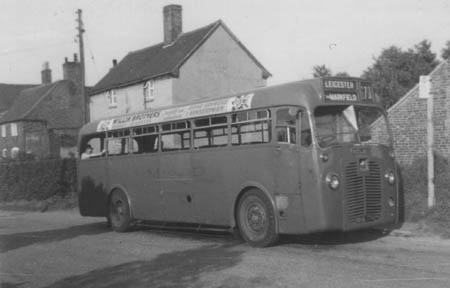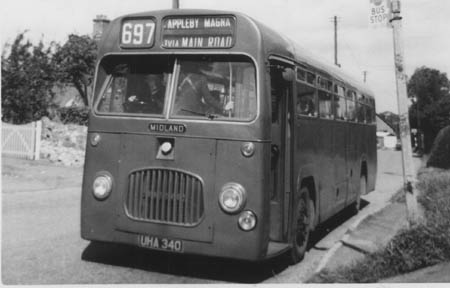Appleby History > Miscellany > Transport in the 20th Century
Appleby's Public Transport in the 20th Century
By Allan Condie
This is an updated version of an article originally published in June 2010. This revised edition published November 2011.
The pictures below were taken at the stop on Top Street just before Snarestone Turn. (Click the pictures for larger views.)
Midland 'Red' 1950 S12 saloon 3774 which has just arrived from Leicester on service 670 on a Saturday morning c1962. It will leave for Leicester at 9.55.
This service was operated by Coalville Garage and the vehicle involved would have worked into Leicester on another service in time to depart thence for Appleby at 8.10
S14 saloon 4340 on the 4.31 departure for Ashby via Snarestone - the blinds have yet to be reset. This was a Swadlincote duty and the bus involved was
new in 1954 and was built by the operator at its Carlyle Works at Edgbaston, Birmingham. The S14 was a revolutionary lightweight saloon with extensive use of glass fibre in its construction.
Public Transport in Appleby
The nearest railway stations to Appleby were Snarestone and Measham on the Ashby & Nuneaton Joint Railway. The line opened on 1st August 1873. It left the Leicester to Burton line at Moira by way of a triangular connection, passenger facilities being provided at Donisthorpe, Measham, Snarestone, Shackerstone, Market Bosworth, Shenton, Stoke Golding and Higham on the Hill with connections to both Stations at Nuneaton.
By the turn of the 19th Century most of the Appleby Farmers were sending milk to London via Snarestone Station. In addition goods facilities there provided means of transport for livestock, produce and grain, and coal in bulk was often purchased and delivered, farmers collecting their own supplies expressly for use by the threshing contractor when visiting their farms with the traction engine.
Passenger services on the Joint Railway line had never really caught on and it was no surprise when these were discontinued on 12th April 1931. In the meantime the Road Traffic Acts and the interest financial and otherwise taken in the major bus Companies by the Railways paved the way for the easy replacement of those passenger trains by buses.
The first recorded bus service by Midland “Red” was a Thursday only service linking Nuneaton and Burton on Trent which started in 1924. This ran via Harts Hill, Atherstone, Sheepy Magna, Twycross, Appleby Magna, Netherseal, Overseal and Castle Gresley. It originally carried the route number 64D, became the 547 and then the 764. It was suspended as of 6th January 1940 and not reinstated after the War.
In 1928 a daily service 713 from Appleby Magna to Burton on Trent was offered by the extension of the 712 service from Measham, this too was a wartime casualty ceasing on 6th January 1940. Three return journeys were offered daily.
Ashby de la Zouch and Measham were already served by the buses of C. W. Moore who traded as “Moore’s Blue” and these routes succumbed to Midland “Red” takeover in 1937, Moore’s Ashby - Measham service became Midland “Red” route 722, and at the time of the takeover provided for journeys arriving at Appleby from Ashby and returning thence at 8.10 am. 1.7 pm (Wednesdays only), and 4.15 pm. these being co-ordinated with the requirements to transport pupils to Ashby Grammar Schools.
At that time (1937), the Midland “Red” service 697 did not operate via Appleby Magna.
In addition, the express service X99 from Birmingham to Nottingham passed along the A453 trunk road and provided an hourly opportunity to travel to Measham, Ashby or Tamworth and beyond provided the intending passenger was prepared to walk from the village up Rectory or Measham Lanes. This service was started in 1928 and Barton also ran a similar service over the same route, which resulted in some racing and undesirable activities.
The Road Traffic Acts came in to prevent such wasteful competition and as a result Barton gave up their part of the service in exchange for Midland “Red’s” Leicester to Nottingham service. The pre-war services were X99, which operated via Mile Oak, and the X98, which went via Curdworth, this latter having been the Barton route. The X98 was a wartime casualty; whilst post-war the two hourly X99 eventually became hourly and operated unchanged right into the 1970s, even to the extent of retaining crew operation with Conductors.
The Ashby to Nuneaton service 697 was suspended as a through route on 24th September 1939, and the 722 service amended to become a circular one operating outwards via Measham and Bird’s Hill, and inwards via Snarestone and Atherstone Road, Measham. Due to the closure of the bridge between Snarestone and Measham in 1947, the 697 was diverted via Appleby Magna. Following representations by the Parish Council to the Traffic Commissioners, this became permanent from 27th September when other changes at the Nuneaton to Market Bosworth end of the route were made.
By 1948 Appleby was well served by the Midland “Red” with four service 697 journeys each way to Ashby and Nuneaton on weekdays and Saturdays, and two on Sundays. It will be noted that there were at that time no late journeys, the 722 still providing the basic service to cope with the school requirements, it should be noted that Ashby Grammar Schools assembled on Saturday Mornings and dismissed at Wednesday lunchtimes to allow for sporting activities.
A late Saturday journey to Appleby was introduced on the 722 in 1950 arriving at 1048 pm. but this only returned as far as Measham where it became a 712 and returned to Swadlincote Garage. Appleby Journeys on service 722 were renumbered 697 in November 1953.
One-man operation came to the 697 on 29th November 1958, also affecting certain journeys of the former 722. The late weekday run through to Nuneaton was withdrawn, and as this route was operated by one saloon from Swadlincote and one from Nuneaton timings were adjusted for these two vehicles to meet at Market Bosworth and transfer passengers to allow drivers and vehicles to return to their own depots. Saturday and Sunday timings remained basically the same but in 1966 Sunday service was withdrawn on the 697. This route continued until 31st August 1971 when it was withdrawn completely, but a revised Ashby-Measham-Appleby Magna-Snarestone-Measham-Ashby service continued in National Bus Company Days eventually becoming Midland “Red” East services 186 and 187, the latter operating via Packington. The X99 continued to operate into the era of deregulation in the 1980s and it too was withdrawn altogether, having been replaced in various ways by various operators since that decade.
In 1955, service 670 from Leicester to Shackerstone via Ellistown Hotel was diverted at Swepstone covering one morning and one afternoon journey on Wednesdays and Saturdays to allow passengers from Appleby to reach the County Town. This facility was withdrawn in 1970, the Wednesday bus having been curtailed at Heather by 1962.
Scholars attending Ibstock Secondary Modern School after opening in 1925 were initially drawn from the locality, but changes in the education system by 1933 meant that Appleby pupils had to be transported there by Contract Carriage. The buses were provided for many years by Blockleys of Heather who traded under the name of Ruby Coaches.
The Biscuit factory at Ashby de la Zouch owned by Meredith & Drew who later became part of the United Biscuits empire relied on a workforce drawn from a wide area and transport was provided initially by Midland “Red” as part of the normal service pattern taking into account works journeys. The inevitable reduction in services and the need to attract a workforce from a wider area resulted in works transport being contracted to Machins of Ashby; at certain times vehicles operated via Appleby Village according to demand, but at others, those requiring transport to work had to walk to the main A453 road to avail themselves of the facility. Clutsam & Kemp also provided buses at one time for their workforce and Brown’s Blue provided these on a private hire basis.
Allan T Condie, November 2011
Also by Allan Condie



